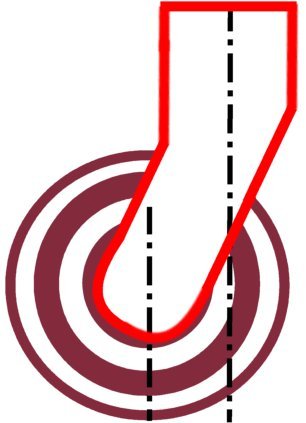|
|
Caster
In multi-track vehicles, the caster influences, together with the steering axis inclination, the reset forces of the steered wheels and the camber when cornering. A low caster causes the steering to be more smooth and
sensitive, at high speed driving however, it makes it less stable. A high caster stabilises very strongly, it does however, cause the steering to be heavy and sometimes at low speeds can even cause it to flutter.
The caster generally describes the distance that the tyre travels after it's track point. The track point is the spot at which the swivel axis of the wheel contacts the road. With the very often used McPherson strut, the
swivel-axis is the line through the crown bearing at the top and the ball bearing in the lower wishbone. The swivel axis can be at a slant, or vertical in front of the wheel center, as in a shopping cart. The latter is also
called caster-offset. Often both are effective (e.g., in bicycles - see first picture).

Very often the pivot axis is formed by the center of the dome bearing at the top and the ball joint in the lower transverse link. The pivot axis can be tilted or, as with the
shopping cart, should be arranged perpendicular to the center of the wheel. The latter is also called after-run offset. Often, both are effective (see picture above).
If you enlarge this picture, you can see the greater distance between the two horizontal lines at the bottom wheel compared to the wheel above it. This distance shows the lever arm with which the forces acting upon
the center of the wheel will try to bring it into a straight line. It is bigger at the bottom, because the caster is bigger there.
Caster is the distance with which the tyre follows its track point. This is the point at which the steering axis of the wheel meets the roadway. However, the influence of the
spreading, which increases the camber on the curve-inside-wheel and reduces it on the curve-outside-wheel, must be taken into consideration. To ensure that the latter does not become positive, the caster (e.g.
with 10°) is never smaller than the spreading (e.g. 6°). The high given values of the caster, show that a so called fore-running is practically non-existent.
The greater the angle of the swivel axis is to the perpendicular, the more difficult it becomes to move the steering from the center position. Shifting the swivel axis forward improves the straight-running stability,
(almost) without the disadvantage of heavier steering. A further possibility of a caster occurs with every tyre, as long as it's not mounted on a driven wheel. If the wheel is drawn, then the tyre to road surface contact area
is shifted slightly to the rear. This could also be called tyre-trailing. This in addition, also causes the steering to return to the center position after cornering.
To properly understand the caster, one should examine it on a two-wheeled vehicle. Here, both types of the above described caster are found together. The caster-ofset is shown by the distance between the red and
the blue line at the bottom of the picture. If the swivel axis (red line) would be vertical, the relationship would be similar to that in a shopping cart. The wheels would always trail by this amount. The camber, when
cornering, would not change.
On a bicycle, the caster-offset is reduced due to the forward curve of the front fork. This is also necessary, because a too large offset, in principle, has a stabilizing effect, indeed, together with the slanting position of
the swivel axis, it causes the front end to be lowered when cornering sharply, which again has a de-stabilizing effect. Therefore, the slant and the offset must have a balanced relationship to each other.
Under normal circumstances a standard bicycle will hardly dip at all, up to a certain steering angle. This effect, by the way, cannot be noted in two-track vehicles because the two sides stabilize each other through the
steering connection. If however, the adjustment values on the right are different from those on the left, it will certainly be noticed in the steering. By the way, bicycles without a caster (offset) are only used by cycle-artists.
These bicycles are not to ride in a straight line.
10/16
| The caster is measured as camber when the steering is turned. |
|
|